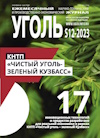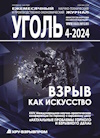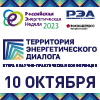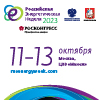
SAFETY
Original Paper
UDC 622.822.22© V.A. Portola, O.I.Cherskikh, Protasov S.I., E.A. Seregin, I.A. Shvakov, 2022
ISSN 0041-5790 (Print) • ISSN 2412-8333 (Online) • Ugol’ – Russian Coal Journal, 2022, № 12, pp. 54-60
DOI: http://dx.doi.org/10.18796/0041-5790-2022-12-54-60
Title
RESEARCH INTO EFFECTS OF ANTIPYROGENS ON THE SPONTANEOUS COMBUSTION OF BROWN COAL
Authors
Portola V.A.1, Cherskikh O.I.2, Protasov S.I.3, Seregin E.A.3, Shvakov I.A.2
1Gorbachev Kuzbass State Technical University (KuzSTU), Kemerovo, 650000, Russian Federation
2Solntsevsky Coal Mine LLC, Shakhtersk,694910, Russian Federation
3KUZBASS NIIOGR Innovation Company, Kemerovo, 650000, Russian Federation
Authors Information
Portola V.A.,Doctor of Engineering Sciences,Professor, e-mail: portola2@yandex.ru
Cherskikh O.I., PhD. (Engineering), Director, e-mail: cherskikhoi@eastmining.ru
Protasov S.I., PhD. (Engineering), Director, e-mail: s.i.protasov@mail.ru
Seregin E.A., Chief Engineer, e-mail: eugene_s1976@mail.ru
Shvakov I.A., Head of the Coal Spontaneous Combustion Response Team, e-mail: shvakovia@eastmining.ru
Abstract
Fragmentation of the coal seams activates absorption of oxygen by active centers and the generates heat, which can trigger spontaneous combustion. Treatment of coal accumulations with antipyrogens that slow the absorption of oxygen from the atmosphere can help to prevent spontaneous fires. Considering the broad variation of coal properties in different coal fields, it is necessary to experimentally select the most effective antipyrogen for the coal mined. Laboratory studies have shown that the treatment of non-oxidized brown coal with aqueous compositions significantly reduces the rate of oxygen sorption, while the addition of inert dust has almost no effect on this parameter. Distilled water, aqueous compositions of carbamide and calcium chloride demonstrated the greatest decrease in the oxygen sorption rate. The length of the incubation period of brown coal spontaneous combustion increased 1,6 times due to the wetting and reduction of oxygen sorption. Ageing of the treated samples for 40 days showed that some compositions can activate the sorption capacity of the brown coal over time. Such compositions include aqueous solutions of sodium silicate, calcium carbonate, ammonium chloride. However, an increase in coal moisture content after treatment with these compositions contributed to extending the incubation period of spontaneous combustion. A water composition with addition of 10% calcium chloride proved to be the most effective antipyrogen. Retreatment of the brown coal samples with these compositions after 40 days of air exposure showed that treatment with calcium chloride increases the duration of the incubation period of spontaneous combustion to the greatest extent, and the sodium silicate increases the rate of oxygen sorption.
Keywords
Coal spontaneous combustion, Spontanuos fire, Antipyrogens, Oxygen sorption by coal, Incubation period of spontaneous combustion, Open-strip mine, Brown coal, Prevention of spontaneous combustion.
References
1. Portola V.A., Skudarnov D.E., Protasov S.I. & Podobrazhin S.N. Estimation of parameters of spontaneous combustion sources in rock dumps of coal mines and methods of their extinguishing. Labor safety in industry. 2017, (11), pp. 42-47. (In Russ.).
2. Skochinsky A.A. & Ogievsky V.M. Mine fires. Moscow, Gornoe Delo Publ., Cimmerian Centre LLC, 2011, 375 p. (In Russ.).
3. Veselovsky V.S., Alekseeva N.D., Vinogradova L.N., Orleanskaya G.L. & Terpogosova E.A. Spontaneous ignition of industrial materials. Moscow, Nauka Publ., 1964, 246 p. (In Russ.).
4. Lin Q., Wang S., Song S., Liang Y. & Ren T. Analytical prediction of coal spontaneous combustion tendency: velocity range with possibility of self-ignition. Fuel Processing Technology, 2017, (159), pp. 38-47.
5. Portola V.A. Assessment of the effect of some factors on spontaneous coal combustion. Journal of Mining Science, 1996, (32), pp. 212-218.
6. Onifade M. & Genc B. Spontaneous combustion of coals and coal-shales. International. Journal of Mining Science and Technology, 2018, (28), pp. 993-940
7. Zhang Y., Liu Y., Shi X., Yang C., Wang W., Li Y. Risk evaluation of coal spontaneous combustion on the basis of auto-ignition temperature. Fuel, 233 (2018), pp. 68-76.
8. Semenova S.A., Patrakov Yu.F. & Mayorov A.E. In-situ oxidation of coals and methods to assess the tendency of coals to oxidation and spontaneous combustion (an overview). Koks i himiya, 2020, (5), pp. 12-21. (In Russ.).
9. Wei D., Du C., Lei B. & Lin Y. Prediction and prevention of spontaneous combustion of coal from goafs in workface: A case study. Case Studies in Thermal in Engineering, 2020, 21, 100668.
10. Zhang L., Qin B. Rheological characteristics of foamed gel for mine fire control. Fire and Materials. 2016. 40 (2). P. 246-260.
11. Kovrizhin O.I., Koliada A.Yu. & Kalinichenko N.A. Utilization of gaseous nitrogen in the elimination of underground fires. Naucnyj vestnik NIIGD «Respirator», 2020, (5), pp. 37-44. (In Russ.).
12. Guidelines for determining the incubation period of spontaneous combustion of coal. Series 05. Issue 38. Moscow, 2013, 24 p. (In Russ.).
13. Safety rules for coal processing, beneficiation and briquetting. Approved by Order No. 428 of the Federal Service for Environmental, Technological and Nuclear Supervision as of October 28, 2020.
14. Guidelines for prevention of freely burning and spontaneous fire hazards at mining operations in the coal mining industry. Approved by Order No. Pr-469 of the Federal Service for Environmental, Technological and Nuclear Supervision as of November 27, 2020.
15. Portola V.A., Bobrovnikova A.A., Protasov S.I. Impact of ambient temperature on the incubation period and the tendency of coal to spontaneous combustion. Bezopasnost? truda v promyshlennosti, 2022, (1), pp. 27-32. (In Russ.). DOI: 10.24000/0409-2961-2022-1-27-32.
For citation
Portola V.A., Cherskikh O.I., Protasov S.I., Seregin E.A. & Shvakov I.A. Research into effects of antipyrogens on the spontaneous combustion of brown coal. Ugol’, 2022, (12), pp. 54-60. (In Russ.). DOI: 10.18796/0041-5790-2022-12-54-60.
Paper info
ReceivedSeptember 29, 2022
Reviewed October 15, 2022
Accepted November 25, 2022









